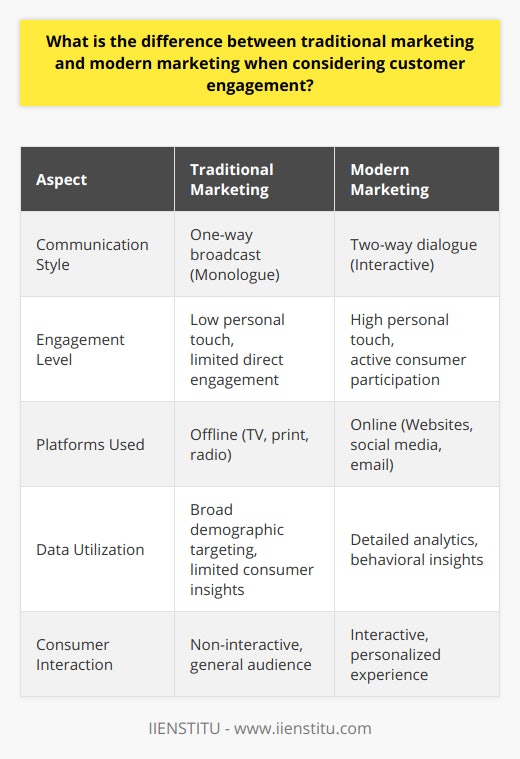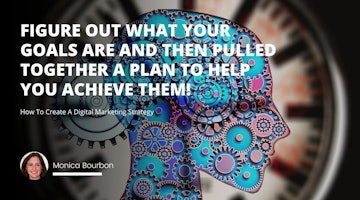Traditional Marketing vs. Digital Marketing: Differences
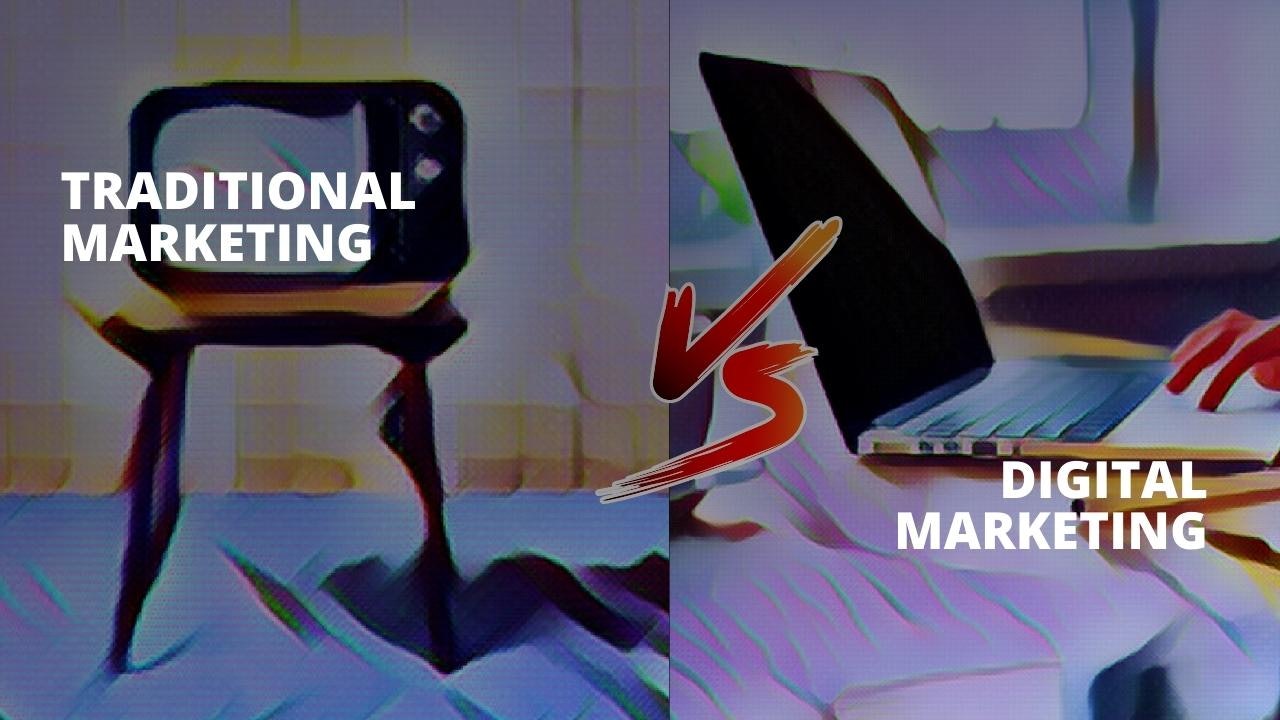
| Marketing Type | Description | Key Features |
|---|---|---|
| Traditional Marketing | Uses promotional techniques to reach out to customers and generate interest in a product or service | Advertising, public relations, direct marketing, print media, TV and radio promotions |
| Digital Marketing | Uses electronic channels to promote or market products and services | Search Engine Optimization (SEO), pay-per-click (PPC) advertising, social media marketing, email marketing |
| Measurability | Ability to track and measure the impact of marketing efforts | Traditional marketing measurement methods rely on brand awareness or sales figures, while digital marketing can be easily tracked and measured using analytics tools |
| Target Audience | Groups of individuals a campaign is designed to reach | Traditional marketing reaches broad audience while digital marketing commonly targets specific demographics based on data and insights |
| Interactivity | Level of engagement with potential customers | Traditional marketing offers limited interaction opportunities, while digital marketing allows direct engagement with potential customers |
| Cost | Amount spent to implement marketing strategies | Traditional marketing often comes with high cost while digital marketing is usually less expensive |
| Accessibility | Ease in which information is accessed | Traditional marketing uses physical, tangible mediums while digital marketing utilizes online platforms |
| Future Outlook | Potential growth and adaptability | Traditional marketing needs to adapt to technological advancements while digital marketing is rapidly evolving and growing field |
| Channels | Mediums utilized to deliver marketing message | Traditional marketing uses television, radio, print, digital media while digital marketing uses email, social media, SEO, and PPC |
| Objectives | Goals or desired outcomes of a marketing campaign | Traditional marketing aims at creating brand awareness while digital marketing usually focuses on awareness, conversion, or engagement |
It’s no secret that the digital age has drastically changed the way businesses operate. While traditional marketing methods are still important, digital marketing has become a key component of most successful marketing plans. This blog post will explore the differences between conventional and digital marketing and discuss why you should consider incorporating digital marketing into your business plan. Stay tuned!
Related Course: Digital Marketing Free Course
The most significant difference between traditional marketing and digital marketing is how consumers access information. Traditional marketing was focused on print ads, billboards, and television commercials in the past. These methods allowed businesses to reach a broad audience, but they were also costly. In addition, traditional marketing techniques did not allow for much interaction or engagement with potential customers.
Digital marketing, on the other hand, is focused on online platforms such as social media, websites, and email. This type of marketing is much less expensive than traditional marketing. It allows businesses to interact directly with potential customers. Additionally, digital marketing provides enterprises with valuable data and insights about their target audience.
Another critical difference between traditional marketing and digital marketing is how each type of marketing is measured. Traditional marketing efforts are often difficult to measure because they rely on brand awareness or sales figures. Digital marketing, however, can be easily tracked and measured using analytics tools. This data can then be used to improve future marketing campaigns.
So, why should you consider incorporating digital marketing into your business plan? Digital marketing is a powerful tool that can help you reach your target audience, interact with potential customers, and track your marketing efforts. Additionally, digital marketing is much less expensive than traditional marketing, making it an excellent option for small businesses. If you do not already know digital marketing and the differences between traditional marketing, now is the time to learn in this blog!
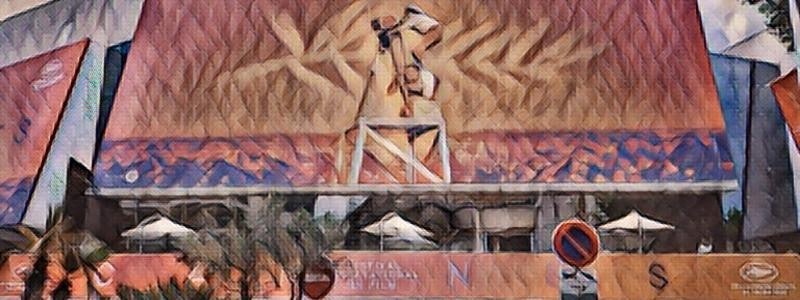
What is Traditional Marketing?
Traditional marketing uses promotional techniques to reach out to customers and generate interest in a product or service. It typically involves activities like advertising, public relations, and direct marketing.
What are traditional marketing channels?
Traditional marketing aims to create awareness about a brand or product and persuade customers to purchase it. Businesses use various channels to reach their target audience, including television, radio, print, and digital media.
Evaluating the effectiveness of traditional marketing
Traditional marketing can be very effective in promoting products and services and generating sales. However, it can also be quite expensive, especially for small businesses. Additionally, it can be challenging to measure the results of traditional marketing campaigns.
Despite these challenges, traditional marketing remains an essential part of many businesses marketing strategies. It can be beneficial for companies just starting out and need to create a lot of awareness about their brand quickly. In addition, traditional marketing can complement other marketing efforts, such as digital marketing.
The future of traditional marketing
Looking to the future, it’s likely that traditional marketing will continue to play a role in business. However, the exact nature of that role is yet to be determined. As technology evolves and new channels emerge, traditional marketing will likely need to adapt to stay relevant. But, given its long history and proven effectiveness, there’s an excellent chance to remain an essential part of the marketing mix for years to come.

What is Digital Marketing?
Digital marketing is the process of using electronic channels to promote or market products and services. Common examples of digital marketing channels include email, social media, search engine optimization (SEO), and pay-per-click (PPC) advertising.
What are digital marketing objectives?
Digital marketing objectives usually fall into three categories: awareness, conversion, or engagement. Awareness objectives focus on getting people to learn about a brand or product. Conversion objectives concentrate on getting people to take the desired action, such as making a purchase. Finally, engagement objectives focus on getting people to interact with a brand or product in some way, such as leaving a positive review.
What are some of the most common digital marketing channels used today?
Email is often seen as one of the most effective digital marketing channels because it allows businesses to directly contact their target audience. However, email can also be one of the most challenging channels to master due to its ever-changing algorithms and spam filters.
Social media is another popular digital marketing channel that can be highly effective when used correctly. However, businesses must be careful not to overdo it with their social media presence or risk coming across as spammy or inauthentic.
Search engine optimization (SEO) is a digital marketing strategy that improves a website’s visibility in search engine results pages (SERPs). By optimizing their website for specific keywords, businesses can attract more qualified leads to their site. However, SEO takes time and effort to master and keep up with the latest algorithm changes.
Pay-per-click (PPC) advertising is a digital marketing channel that allows businesses to pay for ads on SERPs. PPC can be an effective way to drive traffic to a website, but it can also be expensive if not managed properly.
When used correctly, digital marketing channels can be highly effective in promoting and selling products or services online. However, it’s essential to understand the pros and cons of each channel before investing too much time or money into any one particular strategy.
What are the benefits of using digital marketing for businesses?
Digital marketing is a critical component of modern business strategy. By utilizing digital channels, businesses can connect with customers with who they are already spending time online. This helps companies to reach a larger audience and promotes brand awareness. Additionally, digital marketing can target specific customers with personalized messages, increasing the likelihood of conversion.
Digital marketing is an essential part of any business’s marketing mix. By incorporating digital marketing into your overall marketing strategy, you can reach a larger audience and achieve your business goals.
Similarities between traditional and digital marketing
There are a few key similarities between traditional and digital marketing. First, both types of marketing rely heavily on audience research and segmentation to be effective. Additionally, both involve using various channels to reach consumers, including television, radio, print, and online.
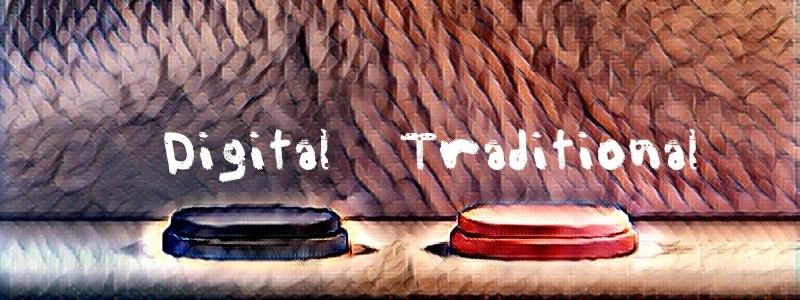
Traditional Marketing vs. Digital Marketing
One of the most significant differences between traditional and digital marketing is how consumers receive information. Consumers typically receive information through one-way channels like television or print ads with traditional marketing. However, with digital marketing, consumers can seek out information themselves through two-way channels like social media or search engines. This allows for a more interactive and engaging experience for the consumer.
Digital marketing also offers some advantages over traditional marketing when measuring results. For example, businesses can track data like website traffic, sales conversions, and click-through rates with digital marketing. This information can adjust campaigns and strategies in real-time, making digital marketing a more flexible and responsive tool. Additionally, digital marketing is often less expensive than traditional marketing methods, making it a more viable option for small businesses and startups.
In the end, both traditional and digital marketing have their own strengths and weaknesses. By understanding these differences, businesses can create a more well-rounded marketing strategy that combines the best of both worlds.
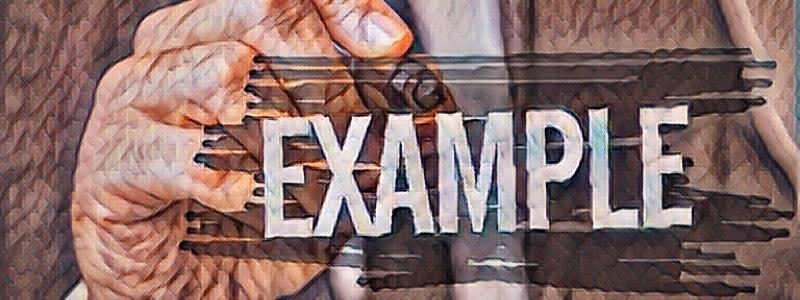
Examples of Traditional and Digital marketing
Traditional marketing refers to any type of marketing done through offline channels, such as print, TV, radio, and direct mail. Digital marketing, on the other hand, refers to any type of marketing that is done online through channels such as search engines, social media, email, and websites.
Examples of Traditional Marketing
Traditional marketing includes print advertising, radio and television, and direct mail.
Print advertising
Print advertising can be in newspapers, magazines, or billboards.
Radio and television advertising
Radio and television advertising is another form of traditional marketing that uses audio or visual messages to promote a product or service.
Direct mail
Direct mail is a type of marketing that involves sending physical materials like postcards or flyers to potential customers.
Examples of Digital marketing
Marketing isn’t just about billboards and TV ads in the digital age. If you want to reach your target audience, you need to be where they are: online. That’s where digital marketing comes in.
Digital marketing is an umbrella term that covers a variety of marketing activities. Here are some examples:
Website design and development
Your website is often the first impression potential customers will have of your business, so it’s essential to make sure it’s designed and developed with your target market in mind. A good website will be user-friendly, visually appealing, and informative, providing visitors with everything they need to know about your products or services.
Search engine optimization (SEO)
SEO is about improving your website’s visibility on search engine results pages. By optimizing your site for relevant keywords and phrases, you can attract more visitors looking for what you have to offer.
Social media marketing
Social media is a powerful platform for connecting with potential and current customers. By regularly posting engaging content, you can build relationships, drive traffic to your website, and generate leads and sales.
Content marketing
Content is a great way to educate your audience about your products or services and build trust and credibility. By creating helpful, informative blog posts, articles, eBooks, and infographics, you can reach your target market and establish yourself as an expert in your field.
Pay-per-click (PPC) advertising
PPC is a form of online advertising that allows you to pay for placement on search engine results pages. By bidding on relevant keywords, you can reach potential customers actively searching for what you have to offer.
Digital marketing is a necessary part of doing business in the modern world. By using these various marketing strategies, you can reach your target audience where they are and promote your products or services effectively.
Although the digital age has brought about many changes, including how we market our products and services, one thing remains unchanged- the need for a well-executed marketing strategy. Whether your business is just starting out or looking to revamp your current plan, it’s essential to understand the differences between traditional and digital marketing. Our digital marketing course can help you create a winning strategy to reach more customers and increase ROI. So join us today to get started!
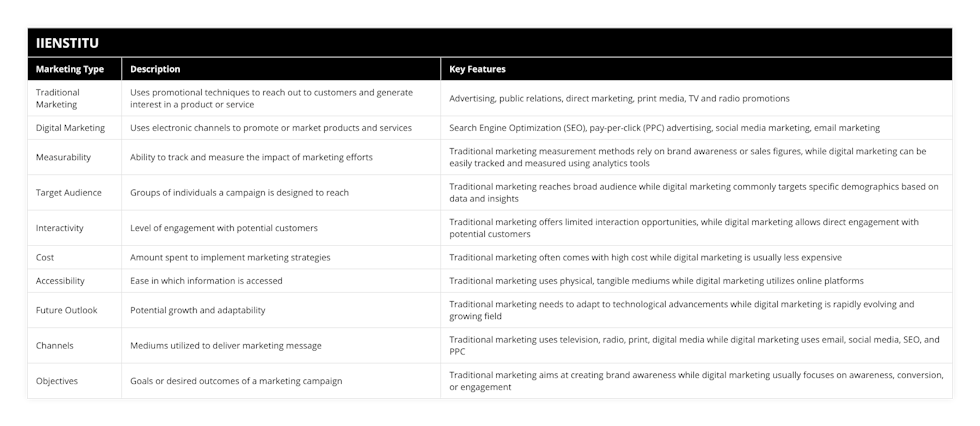

She describes himself as someone who loves to write about digital marketing, social media and public relations. His personal development special interest lies in self-improvement through reading books on the subject of human behavior; she also has an eye for how these topics apply outside just business or career settings too!









